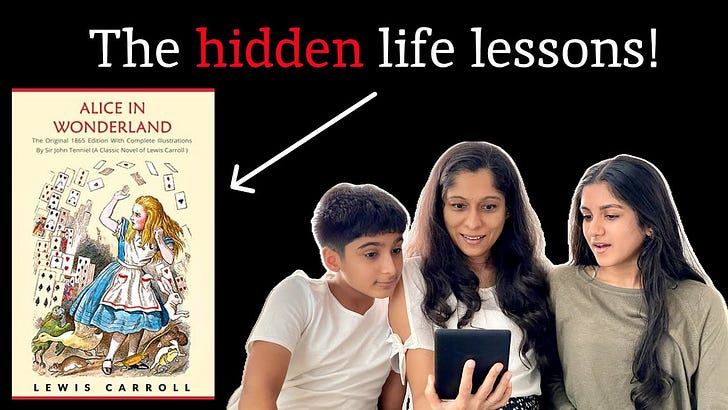Hello there! As promised last week, here’s the video my kids and I created after re-reading the children's classic, Alice’s Adventures in Wonderland. Sorry about the poor video quality..noob issues.
While reading, I like to pause, think, and reflect. It makes me a slow reader but it has its advantages. It helps me connect it with something else I read, watched, or felt the other day. The best part is that these reflections are uniquely yours! Imagine: 10 people reading the same book can have hundreds of unique reflections. Just like with reading, taking it slow in a “certain” way has its advantages in other areas like while building a business or growing healthy relationships. What way is that? That's what today's edition is about — The Red King Effect. It's quite the opposite of the Red Queen Effect we explored before. I’ll recap it before we move to the Red King Effect for a better understanding of how we can benefit from each. Enjoy the read!
Imagine a pond with frogs. These frogs eat flying insects. Over time, some frogs develop sticky tongues — a big advantage for catching their prey. These frogs thrive, and soon, many frogs have sticky tongues. For a while, there are more frogs than insects. But the insects catch up. The ones with extra slippery bodies escape the frogs. These insects survive and reproduce, and soon, most insects are slippery. The proportion of frogs and insects returns to normal.
Both frogs and insects have to adapt quickly just to keep up. This is the Red Queen Effect, named after a scene in "Through the Looking Glass" where Alice has to run as fast as the Red Queen just to stay in place.
This effect isn't just in nature. We see it in medicine, economics, and business too.
Imagine you and a competitor sell a similar product and each owns 50% of the market. Your competitor suddenly increases their marketing budget, boosting their sales and reducing yours. You respond by increasing your marketing budget too. Eventually, the market evens out, but now both companies have higher marketing costs and the same net profits as before.
Both parties are running hard just to keep up. The Red Queen Effect is a game of catch-up. You have to move fast and adapt to survive.
The Red King Effect
While frogs and insects play catch-up, flowering plants and bees work together more slowly. Flowers need to spread their pollen, and bees need food. Over time, flowers develop bright colors and sweet nectar to attract bees. Bees evolve to collect pollen efficiently. Both adapt together, slowly but surely, enjoying mutual benefits. Flowers get pollinated, and bees get food.
Unlike the frogs and flying insects, here it’s a mutually beneficial partnership with better long-term benefits. Both bees and flowering plants, with support from each other, coevolve into more complex beings. Both gain better chances of thriving in nature.
Unlike the Red Queen Effect, the Red King Effect is about mutual support and shared benefits.
Maybe the slow and steady wins the race can be turned into slow, steady, and supportive wins the race.
Let’s apply this to a business scenario.
Think of a software company and a healthcare provider partnering to develop a health monitoring app. The software company provides tech expertise, while the healthcare provider offers medical knowledge. Over time, the software company creates a high-quality app with accurate health data, and the healthcare provider gains a tool to improve patient care.
Both succeed more than they would alone.
Both the Red Queen and Red King effects are mental models you can use to make smarter decisions.
When to use which one?
Red Queen - For Competition
Use this when resources and rewards are limited. For example:
If you're a student applying for a scholarship, only a limited number of students can receive it. It's time to be competitive and work harder and smarter than your peers.
If you're a programmer, you must keep up with the latest tools and technologies. Otherwise, more updated coders will replace you.
Red King - For Cooperation
Use this when teamwork is essential for success. For example:
In a group project at school, collaboration is key to achieving the best outcome.
When building a product at a startup, all teams must work together to succeed.
Understanding the Red Queen and Red King effects can help you make smarter decisions in various aspects of life. Know when to compete fiercely and when to cooperate for mutual benefit. As a leader, parent, or teacher, these insights can help you guide others effectively.
Push for peak performance when necessary, but also foster collaboration to achieve common goals. By balancing competition and cooperation, we can navigate challenges and opportunities more effectively.
Until next time 🙌




